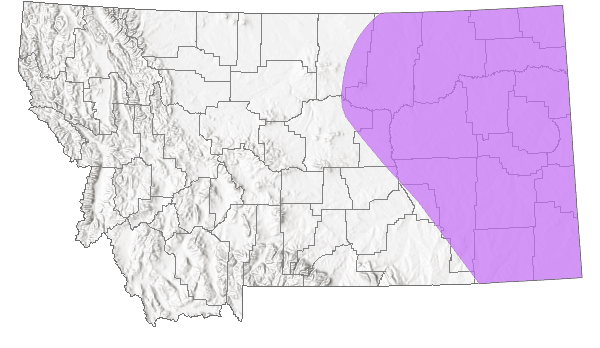View in other NatureServe Network Field Guides
NatureServe
Montana
Utah
Wyoming
Idaho
Wisconsin
British Columbia
South Carolina
Yukon
California
New York
Summer Azure - Celastrina neglecta
General Description
Taxonomy of western North American Celastrina is in flux, with some authorities now elevating lucia, neglecta, and echo to full species, though each was a former subspecies of C. ladon; other authorities include ladon as a synonym for C. argiolus (Scott 1986; Pratt et al. 1994; Guppy and Shepard 2001; Pyle 2002; Acorn and Sheldon 2006; Schmidt and Layberry 2016). Sections of this account probably include information for more than one taxon now considered a full species.
[From Ferris and Brown 1981; Scott 1986; Opler and Wright 1999; Glassberg 2001] Forewing 1.0-1.4 cm. Tailless, lacking orange markings; sexually dimorphic. Upper surface of male powdery blue, often with white patch on hindwing; female pale blue with extensive black along costal and marginal portion of forewing, extensive areas of white on both sets of wings. Undersurface white or pale gray with small blackish marks and a zigzag dark line in submarginal area.
Phenology
One flight northward, several flights southward and in the east (Scott 1986). One flight in North Dakota and Saskatchewan, mainly July (Glassberg 2001). Two flights in southern Ontario, late May to late June and late July to late August (Schmidt and Layberry 2016).
Diagnostic Characteristics
Probably best determined from other blues by being tailless and lacking orange markings; uppersurface of males powdery blue with white patch on hindwing, females blue with some black on outer half of forewing. Undersurface for both sexes white or pale gray with small blackish marks and a zigzag dark line in submarginal area. Flight date perhaps most useful for distinguishing from other species of Celastrina.
Species Range
Montana Range
Range Descriptions

 Native
Native
Range Comments
East of the mountains, from eastern Alberta and central Montana south to central Colorado and eastern Texas, east through southern Canada to Nova Scotia and throughout the eastern US to central Florida (Pratt et al. 1994; Opler and Wright 1999; Glassberg 2001). Not reported from Montana prior to 1993 (Kohler 1980; Stanford and Opler 1993); reported since then from at least 7 counties in the eastern 1/2 of the state (Scott and Wright 1998; FLMNH Lepidopterists' Society database; Butterflies and Moths of North America database). Rare to uncommon in western North America (Glassberg 2001).
Observations in Montana Natural Heritage Program Database
Number of Observations: 1
(Click on the following maps and charts to see full sized version)
Map Help and Descriptions
Relative Density

Recency



 (Observations spanning multiple months or years are excluded from time charts)
(Observations spanning multiple months or years are excluded from time charts)
Migration
Non-migratory.
Habitat
Open woodland, edges, power-line corridors, cultivated fields, urban gardens, prairie (Opler and Wright 1999; Glassberg 2001); most abundant in moderately disturbed prairie and open habitats (Hogsden and Hutchinson 2004), favors sites treated with fire rather than grazing as a prairie-restoration management tool (Vogel et al. 2007). Habitat in Montana described in 1993 as prairie riparian for first Montana records (S. Kohler, FLMNH Lepidpterist's Society database).
Food Habits
Larval food plants include Actinomeris, Agastache, Aralia, Ceanothus, Cimicifuga, Collinsonia, Cornus (several species), Erythrina, Eupatorium, Humulus, Lupinus, Prunus, Rhus, Spiraea, and Viburnum (Scott 1986, 1992, 2006; Pratt et al. 1994). Adults feed on flower nectar (including Ageratina, Anemone, Anethum, Antennaria, Cephalanthus, Clematis, Cornus, Crataegus, Cryototaenia, Justicia, Melanthium, Melilotus, Pastinaca, Rhus, Ribes, Rudbeckia, Sambucus, Sium, Stellaria, Symphyotrichum, Thaspium, Toxicodendron, Trifolium, Verbena, Viburnum) and mud (Tooker et al. 2002; Senchina 2008; Scott 2014; Schmidt and Layberry 2016).
Reproductive Characteristics
Probably similar to other Celastrina species; the following based in part on information for C. ladon of which neglecta was once considered a subspecies. Females lay eggs singly on host plant flower buds (Scott 1986, 1992, 2006). Eggs hatch in about 3-6 days. Larval development rapid, from egg to L4 instar and pupation in 12-25 days after egg-laying. Prepupal L4 instar wanders off host plant before pupating. Adults eclose (emerge) from non-diapausing pupae in 7-19 days; overwinter as pupae. Larvae do not build nests, are tended by ants (Camponotus, Formica, Tapinoma) (Scott 1979, 1986, 1992; James and Nunnallee 2011; Schmidt and Layberry 2016). Males patrol throughout the day near and around host plant shrubs and trees in valley bottoms, on slopes and ridges, in search of females (Scott 1975b, 1986, 2006).
Stewardship Responsibility
References
- Literature Cited AboveLegend:
 View Online Publication
View Online Publication Acorn, J. and I. Sheldon. 2006. Butterflies of British Columbia. Edmonton, Alberta. Lone Pine Publishing. pp.360
Acorn, J. and I. Sheldon. 2006. Butterflies of British Columbia. Edmonton, Alberta. Lone Pine Publishing. pp.360 Ferris, C.D. and F.M. Brown (eds). 1981. Butterflies of the Rocky Mountains. Univ. of Oklahoma Press. Norman. 442 pp.
Ferris, C.D. and F.M. Brown (eds). 1981. Butterflies of the Rocky Mountains. Univ. of Oklahoma Press. Norman. 442 pp. Glassberg, J. 2001. Butterflies through Binoculars: A Field Guide to the Butterflies of Western North America. Oxford University Press.
Glassberg, J. 2001. Butterflies through Binoculars: A Field Guide to the Butterflies of Western North America. Oxford University Press. Guppy, C.S. and J.H. Shepard. 2001. Butterflies of British Columbia: including western Alberta, southern Yukon, the Alaska Panhandle, Washington, northern Oregon, northern Idaho, northwestern Montana. UBC Press (Vancouver, BC) and Royal British Columbia Museum (Victoria, BC). 414 pp.
Guppy, C.S. and J.H. Shepard. 2001. Butterflies of British Columbia: including western Alberta, southern Yukon, the Alaska Panhandle, Washington, northern Oregon, northern Idaho, northwestern Montana. UBC Press (Vancouver, BC) and Royal British Columbia Museum (Victoria, BC). 414 pp. Hogsden, K.L. and T.C. Hutchinson. 2004. Butterfly assemblages along a human disturbance gradient in Ontario, Canada. Canadian Journal of Zoology 82: 739-748.
Hogsden, K.L. and T.C. Hutchinson. 2004. Butterfly assemblages along a human disturbance gradient in Ontario, Canada. Canadian Journal of Zoology 82: 739-748. James, D.G. and D. Nunnallee. 2011. Life histories of Cascadia butterflies. Corvallis, OR: Oregon State University Press. 447 p.
James, D.G. and D. Nunnallee. 2011. Life histories of Cascadia butterflies. Corvallis, OR: Oregon State University Press. 447 p. Kohler, S. 1980. Checklist of Montana Butterflies (Rhopalocera). Journal of the Lepidopterists' Society 34(1): 1-19.
Kohler, S. 1980. Checklist of Montana Butterflies (Rhopalocera). Journal of the Lepidopterists' Society 34(1): 1-19. Opler, P.A. and A.B. Wright. 1999. A field guide to western butterflies. Second edition. Peterson Field Guides. Houghton Mifflin Company, Boston, Massachusetts. 540 pp.
Opler, P.A. and A.B. Wright. 1999. A field guide to western butterflies. Second edition. Peterson Field Guides. Houghton Mifflin Company, Boston, Massachusetts. 540 pp. Pratt, G.F., D.M. Wright, and H. Pavulaan. 1994. The various taxa and hosts of the North American Celastrina (Lepidoptera: Lycaenidae). Proceedings of the Entomological Society of Washington 96(3): 566-578.
Pratt, G.F., D.M. Wright, and H. Pavulaan. 1994. The various taxa and hosts of the North American Celastrina (Lepidoptera: Lycaenidae). Proceedings of the Entomological Society of Washington 96(3): 566-578. Pyle, R.M. 2002. The butterflies of Cascadia: a field guide to all the species of Washington, Oregon, and surrounding territories. Seattle Audubon Society, Seattle, Washington. 420 pp.
Pyle, R.M. 2002. The butterflies of Cascadia: a field guide to all the species of Washington, Oregon, and surrounding territories. Seattle Audubon Society, Seattle, Washington. 420 pp. Schmidt, B.C. and R.A. Layberry. 2016. What Azure Blues occur in Canada? A re-assessment of Celastrina Tutt species (Lepidoptera, Lycaenidae). ZooKeys 584:135-164. doi: 10.3897/zookeys.584.7882
Schmidt, B.C. and R.A. Layberry. 2016. What Azure Blues occur in Canada? A re-assessment of Celastrina Tutt species (Lepidoptera, Lycaenidae). ZooKeys 584:135-164. doi: 10.3897/zookeys.584.7882 Scott, J.A. 1975b. Mate-locating behavior of western North American butterflies. Journal of Research on the Lepidoptera 14:1-40.
Scott, J.A. 1975b. Mate-locating behavior of western North American butterflies. Journal of Research on the Lepidoptera 14:1-40. Scott, J.A. 1979. Hibernal diapause of North American Papilionoidea and Hesperioidea. Journal of Research on the Lepidoptera 18(3): 171-200.
Scott, J.A. 1979. Hibernal diapause of North American Papilionoidea and Hesperioidea. Journal of Research on the Lepidoptera 18(3): 171-200. Scott, J.A. 1986. The butterflies of North America: a natural history and field guide. Stanford University Press, Stanford, California.
Scott, J.A. 1986. The butterflies of North America: a natural history and field guide. Stanford University Press, Stanford, California. Scott, J.A. 1992. Hostplant records for butterflies and skippers (mostly from Colorado) 1959-1992, with new life histories and notes on oviposition, immatures, and ecology. Papilio new series #6. 185 p.
Scott, J.A. 1992. Hostplant records for butterflies and skippers (mostly from Colorado) 1959-1992, with new life histories and notes on oviposition, immatures, and ecology. Papilio new series #6. 185 p. Scott, J.A. 2006. Butterfly hostplant records, 1992-2005, with a treatise on the evolution of Erynnis, and a note on new terminology for mate-locating behavior. Papilio new series #14. 74 p.
Scott, J.A. 2006. Butterfly hostplant records, 1992-2005, with a treatise on the evolution of Erynnis, and a note on new terminology for mate-locating behavior. Papilio new series #14. 74 p. Scott, J.A. 2014. Lepidoptera of North America 13. Flower visitation by Colorado butterflies (40,615 records) with a review of the literature on pollination of Colorado plants and butterfly attraction (Lepidoptera: Hersperioidea and Papilionoidea). Contributions of the C.P. Gillette Museum of Arthopod Diversity. Fort Collins, CO: Colorado State University. 190 p.
Scott, J.A. 2014. Lepidoptera of North America 13. Flower visitation by Colorado butterflies (40,615 records) with a review of the literature on pollination of Colorado plants and butterfly attraction (Lepidoptera: Hersperioidea and Papilionoidea). Contributions of the C.P. Gillette Museum of Arthopod Diversity. Fort Collins, CO: Colorado State University. 190 p. Scott, J.A. and D.M. Wright. 1998. A new Celastrina from the eastern slope of Colorado. Papilio new series #9. 15 p.
Scott, J.A. and D.M. Wright. 1998. A new Celastrina from the eastern slope of Colorado. Papilio new series #9. 15 p. Senchina, D.S. 2008. Summer azure (Celastrina neglecta W. H. Edwards, Lycaenidae) nectaring on poison ivy (Toxicodendron radicans, Anacardiaceae). Journal of the Lepidopterists' Society 62(1): 52-53.
Senchina, D.S. 2008. Summer azure (Celastrina neglecta W. H. Edwards, Lycaenidae) nectaring on poison ivy (Toxicodendron radicans, Anacardiaceae). Journal of the Lepidopterists' Society 62(1): 52-53. Stanford, R.E. and P.A. Opler. 1993. Atlas of western USA butterflies: including adjacent parts of Canada and Mexico. Unpubl. Report. Denver and Fort Collins, Colorado 275 pp.
Stanford, R.E. and P.A. Opler. 1993. Atlas of western USA butterflies: including adjacent parts of Canada and Mexico. Unpubl. Report. Denver and Fort Collins, Colorado 275 pp. Tooker, J.F., P.F. Reagel, and L.M. Hanks. 2002. Nectar sources of day-flying lepidoptera of central Illinois. Annals of the Entomological Society of America 95(1): 84-96.
Tooker, J.F., P.F. Reagel, and L.M. Hanks. 2002. Nectar sources of day-flying lepidoptera of central Illinois. Annals of the Entomological Society of America 95(1): 84-96. Vogel, J.A., D.M. Debinski, R.R. Koford, and J.R. Miller. 2007. Butterfly responses to prairie resotration through fire and grazing. Biological Conservation 140: 78-90.
Vogel, J.A., D.M. Debinski, R.R. Koford, and J.R. Miller. 2007. Butterfly responses to prairie resotration through fire and grazing. Biological Conservation 140: 78-90.
- Additional ReferencesLegend:
 View Online Publication
View Online Publication
Do you know of a citation we're missing? Allen, T.J., J.P. Brock, and J. Glassberg. 2005. Caterpillars in the field and garden: a field guide to the butterfly caterpillars of North America. Oxford University Press.
Allen, T.J., J.P. Brock, and J. Glassberg. 2005. Caterpillars in the field and garden: a field guide to the butterfly caterpillars of North America. Oxford University Press. Brock, J.P. and K. Kaufman. 2003. Kaufman Field Guide to Butterflies of North America. Houghton Mifflin Company, New York, NY 284 pp.
Brock, J.P. and K. Kaufman. 2003. Kaufman Field Guide to Butterflies of North America. Houghton Mifflin Company, New York, NY 284 pp. Layberry, R.A., P.W. Hall, and J.D. LaFontaine. 1998. The Butterflies of Canada. University of Toronto Press. 280 pp. + color plates.
Layberry, R.A., P.W. Hall, and J.D. LaFontaine. 1998. The Butterflies of Canada. University of Toronto Press. 280 pp. + color plates.
- Web Search Engines for Articles on "Summer Azure"
- Additional Sources of Information Related to "Insects"





